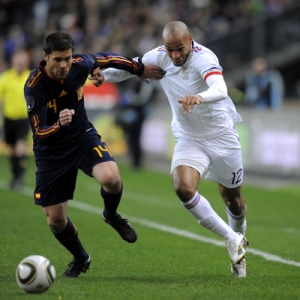2010 South Africa World Cup Stadiums
by Nicholas Tolomeo - 4/23/2010
![]()
Get more World Cup betting information including betting bonuses, World Cup odds and our famous World Cup picks, which in 2006 earned $100 bettors over ten times their initial investment. ($100 bettors earned $1,820 click here for details)

The World Cup is finally coming to Africa. The 19th World Cup, dubbed the biggest sporting event in the world, will be hosted in South Africa, the first African nation to play host to the World Cup. The games will stretch from as far north as Polokwane to the southeastern tip of the country in Port Elizabeth and to the southwestern tip of the country in Cape Town where the draw was announced back in December.
The games will be played in nine different cities and 10 different venues with Johannesburg hosting two stadiums. The stadiums will range in capacity from Johannesburg’s Soccer City at 94,700 to Rustenberg’s Royal Bafokeng Stadium which has a capacity of 42,000.
The tournament opens June 11 when the host nation entertains Mexico in a historic match in Soccer City. The World Cup champion will also be crowned in Soccer City on July 11. The stadium will host eight events throughout the tournament.
Johannesburg’s Soccer City stadium has been open since 1989, but it has undergone drastic changes in the past two years in anticipation of the World Cup. The stadium formerly known as FNB (First National Bank) Stadium expanded from 80,000 capacity to 94,700, making it the largest stadium in all of Africa.
Formerly this building has hosted such historic events as Nelson Mandela’s famous speech upon being released from prison, former South African Communist Party leader Chris Hani’s funeral and the 1996 African Cup of Nations soccer tournament.
Johannesburg’s second stadium is better known as one of the top rugby venues on the continent. Ellis Park Stadium can accommodate 62,567 fans, making it the fourth largest venue in the World Cup. It hosted the 1995 Rugby World Cup, which was won by South Africa. In what amounted to a dry run for the upcoming World Cup, Ellis Park Stadium was one of the hosts for the 2009 Confederations Cup.
For the most part the venues are concentrated in the northeastern part of the country with Cape Town and Port Elizabeth in relative exclusion in the deep south of South Africa. Cape Town will host the second game on day one when Uruguay plays France. Cape Town Stadium was built just for this World Cup. The stadium sits near alongside the waterfront and with a capacity of 69,070, is the third largest World Cup venue.
The second-largest World Cup venue is in Durban, a busting port and tourist city that is the third largest in South Africa. The stadium, named Mose Mabhida Stadium, is also the most visually striking of the South African venues. The 70,000-seat capacity stadium has a magnificent arch that towers over the field some 106 meters above the actual playing surface. Patrons can actually ride a cable car to the top of the arch. The stadium was officially completed on Nov. 24, 2009. It will host a total of seven World Cup games including a semifinal match.
The United States will begin its quest for the World Cup in the smallest venue of the tournament. They will face England in Royal Bafokeng Stadium, an 11-year old stadium in Rustenburg that seats 42,000. The capacity of the stadium was recently upped by 4,000 so it could meet the requirements to host World Cup soccer.
Another smaller World Cup venue is Mbombela Stadium in Nelspruit. If you are worried about pronouncing the name do not worry, it is likely that everyone will be referring to the 43,500-seat capacity stadium by its nickname, the Giraffe Stadium. What spectators will remember about this stadium is that the roof supports closely resemble giraffes. And it is only fitting considering Kruger National Park is just a bicycle kick away from the stadium. The stadium was built specifically for the World Cup and 95 percent of its seats are protected from the elements by an overhanging roof.
Another newly built coastal stadium is the Nelson Mandela Bay Stadium in Port Elizabeth. It is a five-tier stadium with a beautiful outside roof that resembles a blooming flower. The stadium seats 48,000 and is relatively secluded from the rest of the venues, sitting over 700 kilometers away from the next closest World Cup venue city, Cape Town.
The fifth and final newly-built stadium for the World Cup is in Polokwane. Peter Mokaba Stadium is named after Nelson Mandela’s former deputy minister. The stadium seats 46,000 and it’s scheduled to host four World Cup games in the group stages.
In Bloemfontein, a 48,000-seat stadium will host six World Cup games. Free State Stadium has already seen its fair share of athletic competition. Three teams call it home including two rugby teams, the Free State Cheetahs and the Central Cheetahs and soccer team Bloemfontein Celtic. Like the rest of the older venues in South Africa that are hosting World Cup games, Free State Stadium underwent plenty of upgrades including floodlight improvements, sound system upgrades and the installation of an electronic scoreboard.
Most Recent World Cup Betting
- World Cup Betting Advice: Handicapping Host Country Russia
- Netherlands Vs. Spain Predictions
- Uruguay Vs. Germany Predictions
- World Cup Betting Trends for Semifinals
- Germany Vs. Spain Predictions
- Netherlands Vs. Uruguay Predictions
- Paraguay Vs. Spain Predictions
- Argentina Vs. Germany Predictions
- World Cup Players to Watch
- Uruguay Vs. Ghana Predictions
